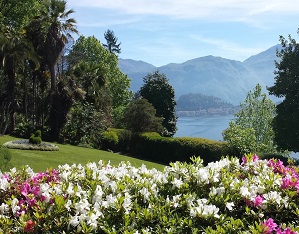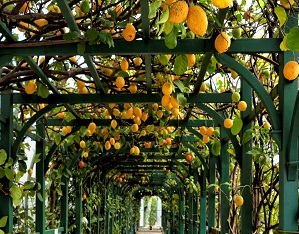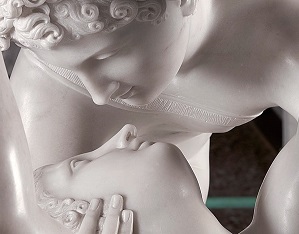Transformed into an exquisite treasure chest for Giovan Battista Sommariva’s collections during the 19th century, the beauty of Villa Carlotta, with its azaleas, hydrangeas and citrus trees collections, complemented by groves of tree rhododendrons and a scenographic fern valley, was prised by Stendhal, Lady Morgan and Flaubert.
Erected around 1690, Villa Carlotta was sold by the descendants of Giorgio II Clerici to Gian Battista Sommariva in 1801. Forty-two years later, the property passed to the House of Saxony-Meiningen, through Albert of Prussia’s daughter, Carlotta, from whom the villa gets its name. Five engravings by Marc’Antonio Dal Re (1743) show the property’s original layout. With its monumental staircase, elevated gardens and citrus tree pergolas, the villa marks the central axis of the complex. By maintaining the balustrade with Candoglia-marble allegories and the fountain of Arion of Methymna, from the Clerici period, Sommariva adapted the property in order to display his rich art collections. The Italian-style formal gardens were complemented by a landscape park area and an agricultural section home to orchards, vegetable gardens, olive groves and vineyards. Other important alterations were introduced by the Saxon-Meiningen family, who remodelled the park to suit the new romantic taste of the second half of the 19th century. Encouraged by the fertile soil (rich in glacial sediments), the Dukes Bernhard and Georg II introduced more than 150 varieties of rhododendrons, camellias and azaleas, which still today offer visitors extraordinary spring blooms. In 1927, after a period of decay following the Great War, the Villa Carlotta Trust restored the property and today the complex welcomes visitors with its charming gardens reflecting in the waters of the lake. Its great variety of plants make Villa Carlotta an authentic botanical garden.
Highlights

Azaleas
Perhaps Villa Carlotta’s most celebrated flower collection, that every spring delivers an intense yet short-lived flowering. Caring for these acidophilic plants requires continuous dedication and a constant supply of fertilisers to counteract the basic characteristics of the soil of Tremezzina.

Scents and colours
The park is home to numerous exotic, rare and monumental plants, such as palms, cedars, incense cedars, redwoods, pines and a large liriodendron. A gallery of citrus trees captivates visitors with its scents, while Harlekin and Goldener Olymp roses, camellias, hydrangeas and azaleas add colour to the emerald-green lawns.

Hydrangeas
Growing in the park since the last century, Villa Carlotta’s hydrangeas today constitute a major collection in terms of consistency and aesthetic quality thanks to the continuous integrations that were made over the last decades, particularly favouring antique varieties. Around the villa and along the garden avenues grow Hydrangeae macrophylla, arborescens and paniculata, as well as other qualities.

The art collections
The villa still holds part of the Sommariva collections. The oratory preserves the family funerary monuments. Cupid and Psyche by Tadolini can be admired in the same room with paintings such as The Last Kiss of Romeo and Juliet by Hayez. Numerous furnishings of the Saxon-Meiningen family are displayed on the second floor.
Find out more
 Villa Carlotta
Contacts
Villa Carlotta
Contacts
Contacts
Telephone:+39 0344 40405 (per info e prenotazioni)
Address
Via Regina, 2
22016, Tremezzina (CO)
 Villa Carlotta
Opening times and prices
Villa Carlotta
Opening times and prices
Opening hours
- Access is limited and organized into 20-minute entry bands.
- You can buy tickets online at website, selecting your preferred time among those available.
- On weekends it is possible to enter Villa Carlotta only by purchasing online or booking by phone (which must be done at least one day before the visit).
Pricing
- Full price: € 12,00
- Over 65 (with identity card): € 10,00
- Student (from 6 to 18 years): € 10,00
- Children (from 0 to 5 years old): free entrance
- Family (2 adults + children from 6 to 18 years old): € 24,00
- Residents of Tremezzina and Griante (with identity card): free entrance
- Membership card: Free entry
- Disabled (with companion): free entrance
 Villa Carlotta
How to get there
Villa Carlotta
How to get there
Address
Via Regina, 2
22016, Tremezzina (CO)
Latitude: 45.624028
Longitude: 9.5080896
How to arrive by road
- From Como: state road 340 to Menaggio.
- From Milan: Motorway A9 Milano-Laghi exit at Lake Como, then state road 340 for Menaggio.
- From Switzerland (Lugano): road Lugano-Menaggio, then state road 340 towards Como.
Once in Varenna or Como you can continue with Navigazione Lago di Como (Tremezzo/Villa Carlotta).
How to arrive by train
- Milano Centrale – Tirano with stop in Varenna Esino, from where it is possible to continue with Navigazione Lago di Como(Tremezzo/Villa Carlotta)
- Milano Centrale – Sondrio with a stop in Varenna Esino, from where you can continue with Navigazione Lago di Como (Tremezzo/Villa Carlotta)
- Milan Porta Garibaldi – Chiasso with a stop in Como San Giovanni
- Milan Cadorna – Como North Lakes
How to arrive by bus
Once in Como you can continue with “Asf Autolinee – Line C10 Como – Menaggio – Colico” (Tremezzo – Villa Carlotta).
 Villa Carlotta
Services/Accessibility
Villa Carlotta
Services/Accessibility
Services
Inside the park is open the cafeteria "Antica Serra", located in the old greenhouse of the villa, where you can have lunch and extend your stay at Villa Carlotta enjoying an incomparable view of the lake.
Free and paid parking spaces are available near Villa Carlotta. During the periods of greatest affluence, it is possible to evaluate the parking Autosilo Villa Mainona in via Peduzzi in Tremezzina.
Dogs are welcome in the garden, but on a leash.
Didactics for schools
To find out about the educational programmes for schools and to book a visit, please consult the website
High chairs for children are available.
A bookshop is available inside the Villa for purchases.
Accessibility
Motor disability
- Two lifts in the garden and a system of lifesavers in the avenues allow people with walking difficulties to enjoy the park. In the museum, instead, the three floors are connected by an internal lift.
Inclusive paths for classes
- All activities at the Villa can be adapted and personalized to meet the needs of those with special needs. By reporting the various needs in advance, the Villa can schedule a telephone interview with the educator who will accompany the school groups. It is also possible to download two handouts designed for visitors suffering from autistic spectrum disorders and disorders affecting the psychic sphere.
 Villa Carlotta
Private events
Villa Carlotta
Private events
At Villa Carlotta you can organize many private events such as weddings, corporate events, private celebrations or photo shoots. For further information please contact the villa at the following e-mail address: [email protected] Further information can be found on the dedicated page on the website of Villa Carlotta
 Villa Carlotta
Itineraries
Villa Carlotta
Itineraries
You could find the garden in these itineraries
 Favorite saving result
Favorite saving result
 Warning!
Warning!
You've have to sign up or sign in to add this element to your favorites.
